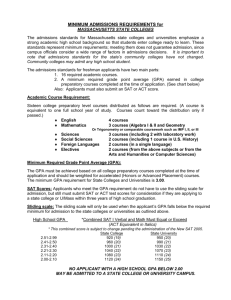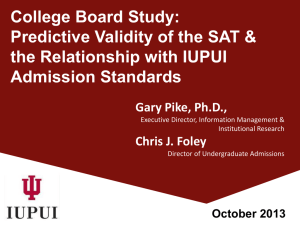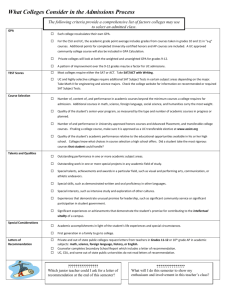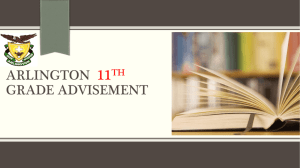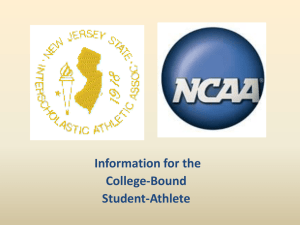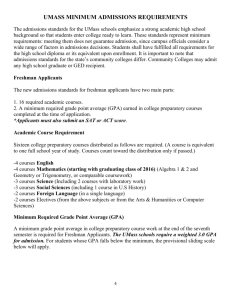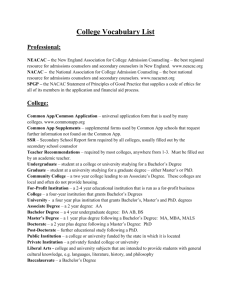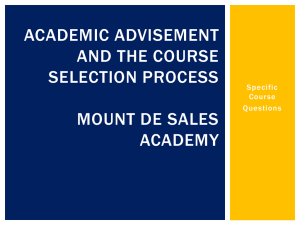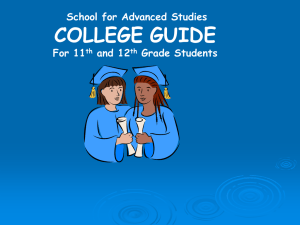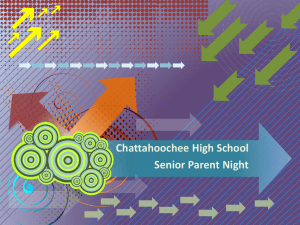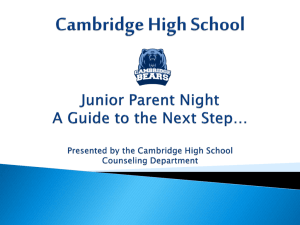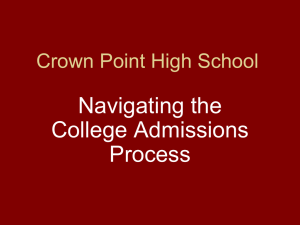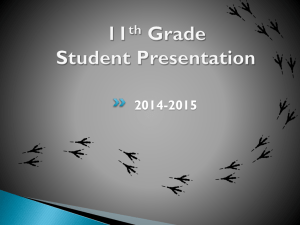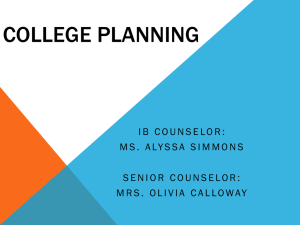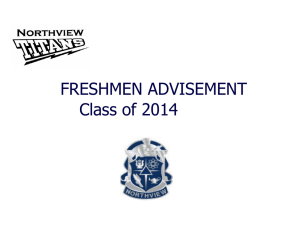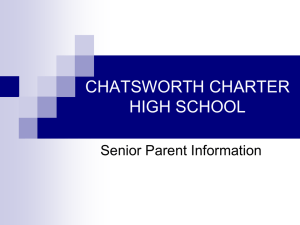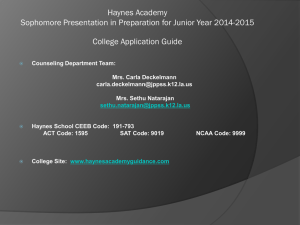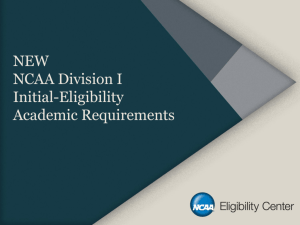Home_files/2015%20JUST%20FOR%20JUNIORS%20PARENT
advertisement
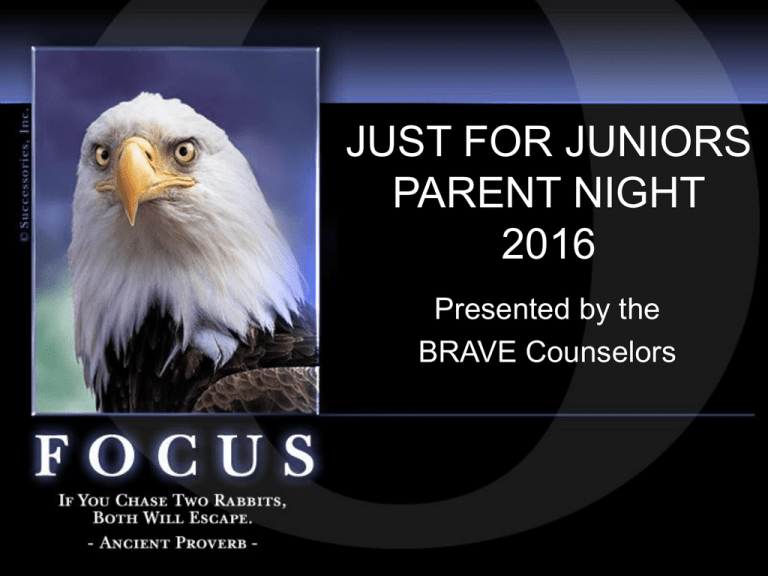
JUST FOR JUNIORS PARENT NIGHT 2016 Presented by the BRAVE Counselors Agenda • • • • • • • • Remediation/Credit Recovery Life After High School NCAA EAP Preparing for College Scholarships 10 Tips for Parents Next Steps for Juniors Remediation • The best option – pass your class(es) the first time • E2020 • Summer school – lottery • ROP – elective credits only • WE – variable elective credits only • Adult School (not CP) • “D” – no additional credits • Alternative setting (Mt. Sac) Words of Wisdom CAREER PATH •If you don’t have a major in mind...take a career interest survey. •College is no longer the place to find your purpose. It’s to define your purpose. Career Interest Inventory ASVAB • Test will be offered for JUNIORS only (March) • Register with Mrs. Campbell (Career Center) • Results will be returned within 2 weeks Life After High School... • • • • • • • • Military World of Work Apprentice Trade/Technical School Community College State College University Independent Life After High School... Military Service • Military academies • ROTC programs • Tuition assistance YOUR FUTURE EDUCATION... • Harvard Graduate School of Education released a report called “Pathways to Prosperity.” 2011 • 47 million American jobs are expected to be created between now and 2018; about two-thirds will require some education beyond high school • About 1 million of these new jobs will be in “mid-skill” occupations that require a post-secondary certificate or associate’s degree • 27 percent of workers with occupational licenses earn more than the average recipient. Types of Colleges Type Description Tuition Admission Requirements Two year Degrees offered: Associates Typically around $4,000/year Open-door admission policy Provides: A way to ease into college / take general college classes for credit. Typically have agreements with four year colleges to transfer credits. Types of Colleges Type Description Tuition Admission Requirements Four year Degrees offered: Bachelors and beyond State: Typically under $25,000/year • • • • • Provides: A well-rounded college experience that includes an academic area of study. Private: Typically more than $25,000/year SAT or ACT GPA Class rank Essay Extracurricular activities • Letters of recommendation • Transcripts College Subject Requirements (a-g) a. History/Social Science – 2 years b. English – 4 years c. Mathematics – 3 years (4 years recommended) d. Laboratory Science – 2 years (3 years recommended) e. Language Other Than English – 2 years (3 years recommended) f. Visual and Performing Arts – 1 year g. College-Preparatory Elective – 1 year Course pattern required for 4 year colleges UC/CSU GPA Requirements • UC requires a 10-12 academic nonweighted minimum 3.0 GPA • CSU requires a 10-12 academic nonweighted minimum 3.0 GPA (eligibility index with SAT/ACT scores) • Competitive/Impacted colleges/majors require a higher GPA and SAT/ACT scores About College Admission Tests • ACT – Consists of four tests: English, Math, Reading, and Science; Writing is optional – Writing component is optional, but choose to take it – Top composite score is 36 • SAT – Consists of three tests: Evidence-based reading and writing, Math, Essay – No penalty for wrong answer • SAT Subject Tests - No longer required for UC and many Independent Colleges; however still highly recommended When Should I Apply? • Start Applying fall of Senior Year • Early decision • Early action NCAA Clearinghouse Students can register with the NCAA Clearinghouse by filling out the Student Release Form (SRF) online after their junior year and submitting their payment online ($70 domestic, $120 international) - www.ncaaclearinghouse.net - Click on Prospective Student-Athletes - Select Domestic or International Student Release Form - Complete the SRF online, print two copies of the transcript release form and give both to their high school counselor NCAA Clearinghouse Division II Division I Graduate from high school Complete the 16 core courses Earn a 2.3 GPA or better in your core courses Earn a combined SAT or ACT sum score that matches your core course GPA and test score sliding scale Graduate from high school Complete the 14 core courses Earn a 2.3 GPA or better in your core courses Earn a combined SAT score of 820 or an ACT sum score of 68. NCAA Clearinghouse Division II Division I 4 years of English 3 years of math 2 years of natural or physical science 1 extra year of English, math, or natural or physical science 2 years of social science 4 years of extra core courses from any category above, or foreign language, non-doctrinal religion or philosophy 3 years of English 2 years of math 2 years of natural or physical science 2 extra years of English, math, or natural or physical science 2 years of social science 3 years of extra core courses from any category above, or foreign language, non-doctrinal religion or philosophy Next Steps for Juniors In School Stay focused on academics Do not lighten your academic load for senior year Stay/get involved in school activities, and/or volunteer efforts Standardized Testing Prepare for ACT / SAT tests (March – June of the Junior Year) Check out websites for SAT/ACT testing information and test prep opportunities Register for AP tests as appropriate College Exploration Explore colleges on the Web College visits if you can Meet with college representatives (Career Center at ALHS) Attend college fairs Apply for Financial Aid and search for Scholarships! Registration for Senior Year • Keep in mind your are selecting YEAR-LONG classes • Keep a healthy balance • Consider extra curricular activities, volunteer work and other obligations. • Consider the amount of study time required to be successful (A, B, C grades) in ALL YOUR CLASSES • Complete the registration packet • Parent’s signature required • Packets due TOMORROW, January 30 to your US HISTORY teacher Best Wishes with YOUR PLANNING! Please remain seated for AP Night
